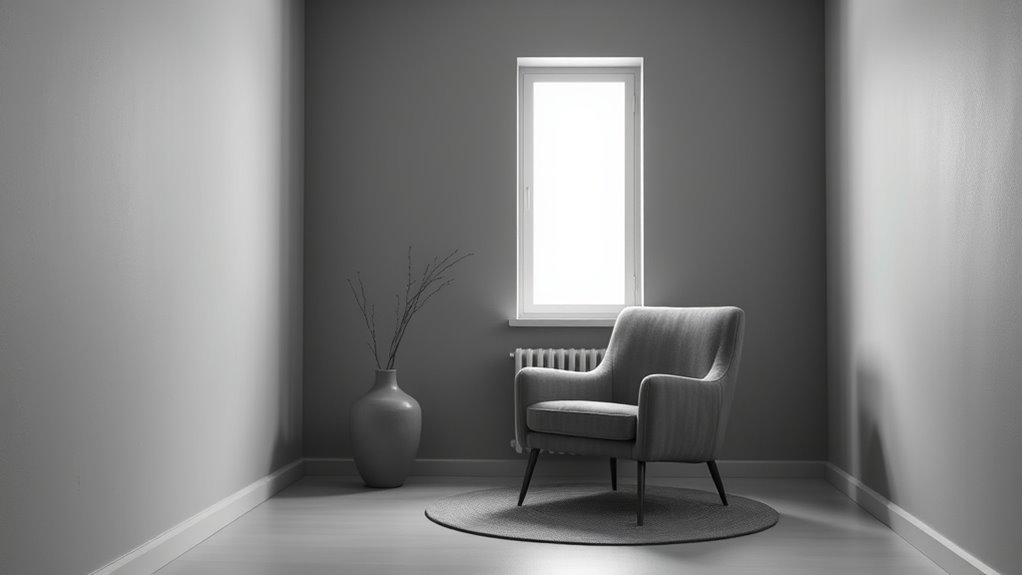To create a monochromatic room, start by choosing a base hue that reflects your mood or style. Experiment with different shades, tints, and tones to add variety and depth. Incorporate diverse textures and finishes, like matte and glossy surfaces, to keep the space interesting. Use accent pieces in slightly contrasting shades to prevent monotony. Proper lighting enhances the color effects, making your space feel cohesive yet dynamic—continue to discover how to master this stylish approach.
Key Takeaways
- Select a base color that reflects your mood or style and explore its shades, tints, and tones for variety.
- Incorporate different textures and finishes, like matte, glossy, and plush textiles, to add depth and visual interest.
- Use accent pieces in contrasting or slightly different shades to prevent monotony and create focal points.
- Adjust lighting to enhance color depth, highlighting textures and subtle variations throughout the day.
- Balance all elements to achieve a cohesive, sophisticated monochromatic space that reflects your personality.

Have you ever wondered how a single color can transform a space? Monochromatic rooms do just that by using variations of one hue to create a cohesive and sophisticated environment. When you choose a monochromatic color palette, you’re working with different shades, tints, and tones of one color. This approach not only simplifies the decorating process but also offers a seamless flow that enhances the overall design cohesion of your space. It’s a powerful technique that allows you to play with depth and texture without the chaos of multiple colors competing for attention.
To start, pick a base color that resonates with your mood or style—whether it’s calming blue, warm beige, or vibrant red. Once you’ve selected your hue, explore its different variations. Lighter shades can bring a sense of airiness and openness, perfect for small or busy rooms, while darker tones add depth and intimacy. Using a well-thought-out color palette, you can balance different elements in the room, such as furniture, accessories, and wall treatments, ensuring that each piece complements the overall theme. The key is to maintain harmony, so your space doesn’t feel disjointed or overwhelming.
Start with a base color that reflects your mood, then explore its shades and tones for harmony and depth.
When creating your monochromatic room, pay attention to the textures and materials you incorporate. Mixing matte, glossy, and textured finishes can add visual interest and prevent the space from feeling flat. For example, pairing a matte wall with shiny metallic accents or plush textiles in similar shades can make the room feel layered and inviting. Additionally, consider the lighting—both natural and artificial—as it influences how colors appear throughout the day. Proper lighting can highlight the subtle differences in your chosen shades, emphasizing the depth you’ve created within your monochromatic scheme.
Another tip is to use accent pieces sparingly but intentionally. While the core of your room will revolve around one color, small accessories like cushions, artwork, or decorative objects in contrasting or slightly different shades can add focal points and prevent monotony. This method enhances your overall design cohesion by tying everything together without breaking the unified color theme. Ultimately, the goal is to craft a space that feels harmonious and balanced, where each element supports the other in creating a unified aesthetic.
In addition, incorporating lighting standards can dramatically influence how your monochromatic scheme appears, ensuring that the colors stay vibrant and true to your vision throughout the day and night. Ultimately, a monochromatic room isn’t about simplicity in design; it’s about mastery of color and texture. By carefully selecting your color palette and paying attention to how each element interacts, you can create a space that feels polished and intentional. It’s an elegant way to showcase your style while maintaining a cohesive, calming environment. With some thought and creativity, your monochromatic room can become a stunning reflection of your taste and personality.
Frequently Asked Questions
How Do I Choose the Right Monochromatic Color Scheme for My Space?
To choose the right monochromatic color scheme, start by selecting a base color that reflects your desired mood setting. Consider your space’s size and natural light; lighter shades can make a room feel open and airy, while darker tones add coziness. Build your color palette with variations of the same hue—incorporate lighter and darker shades for depth. This creates a cohesive, calming atmosphere perfect for your space.
What Are Some Common Mistakes to Avoid in Monochromatic Room Design?
Beware of falling into common pitfalls when designing monochromatic rooms. You might accidentally create a dull space by overusing shades, making it feel flat and uninspired. Watch out for color clashes that disrupt harmony and make the room feel chaotic. To avoid these mistakes, balance your shades carefully, add texture, and introduce subtle contrasts. This guarantees your monochromatic scheme remains engaging without losing elegance or coherence.
Can Monochromatic Rooms Accommodate Bold Accent Pieces Effectively?
Yes, monochromatic rooms can accommodate bold accent pieces effectively. You should use bold accent pieces to add visual interest and create a striking color contrast that stands out against the monochromatic backdrop. Aim for pieces with a different texture or a slightly different hue to avoid overwhelming the space. This approach enhances depth and keeps the room engaging while maintaining the overall cohesive monochromatic look.
How Does Lighting Impact the Overall Look of a Monochromatic Room?
Lighting considerably impacts the overall look of a monochromatic room by enhancing lighting effects and emphasizing color harmony. You should use layered lighting, like ambient, task, and accent lights, to create depth and highlight subtle color variations. Warm lighting can add coziness, while cooler tones offer a sleek feel. Proper lighting accentuates the monochromatic palette, making the space more dynamic and visually appealing without overwhelming the harmony you’ve carefully established.
What Are Budget-Friendly Tips for Creating a Monochromatic Interior?
Think of your space as a canvas waiting for subtle brushstrokes. Use budget decor like affordable throw pillows or curtains in your chosen hue to add depth. Focus on color coordination by mixing different shades and textures of the same color to create visual interest without overspending. Repurpose items, shop sales, and DIY where possible. This approach makes your monochromatic room both stylish and budget-friendly, transforming simplicity into sophistication.
Conclusion
Creating a monochromatic room is like painting your soul in a single hue, where each shade whispers a story of harmony and balance. As you step back and admire your work, remember that this design style isn’t just about color—it’s about crafting a sanctuary that echoes your essence. Embrace the subtle dance of tones, and let your space become a symphony of unity, inviting calm and clarity into every corner of your life.









